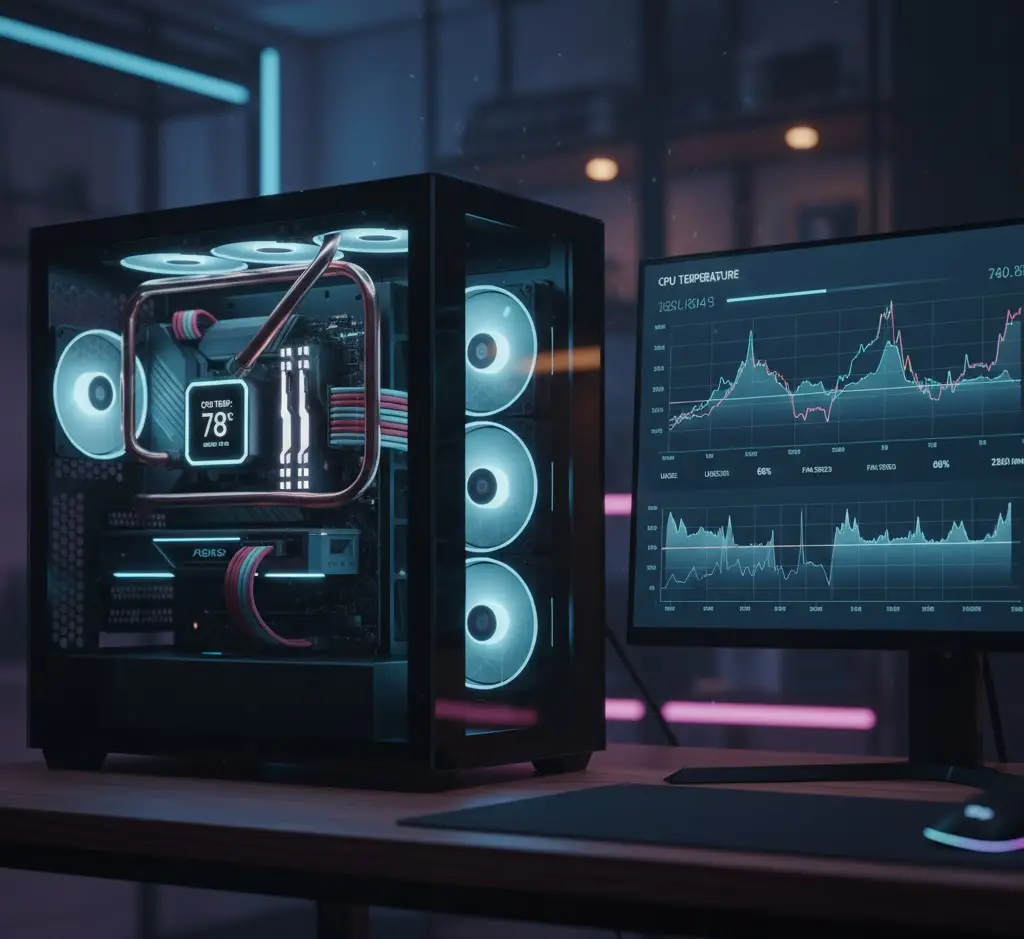If you’re a computer enthusiast or gamer who relies on computers to perform daily tasks, knowing the temperature of your CPU is vital. Overheating could cause your computer to become sluggish or even suffer permanent damage. How do you tell whether your CPU is excessively hot? This is the point where an Monitor of CPU temperatures can help.
The CPU Temperature Monitor is program or hardware instrument that can help monitor the temperature of your processor in real-time. By keeping track of this vital measurement, you can avoid overheating problems and ensure that your system is running at its best performance.
This article will look at the reasons why keeping track of CPU temperature is essential, how to do it, as well as the most effective tools to ensure that your PC stays cool.
What is CPU Temperature and Why Is It Important?
It is the CPU (Central Processing Unit) is the computer’s brain. It performs tasks and executes software, making CPU one of the crucial parts of your computer. As the CPU is performing its duties it creates heat. If the heat generated is not properly controlled, it could result in excessive heat and cause various problems.
What You Need to Know Care About The Temperature of Your CPU:
-
Stopping Overheating The overheated state can cause your computer to slow down performance, leading to lags or crashes during intense tasks such as video editing or gaming.
-
Increased longevity The constant high temperature could reduce the life of your motherboard, CPU as well as the other parts of your internal system.
-
Optimizing Performance A CPU that is cooler performs more efficiently and a proper cooling system can stop unnecessary performance throttle.
Most CPUs function in a safe temperature range between 30-40degC in idle mode and can reach 70-80degC when under extreme loads. Temperatures that are consistently higher than this could result in thermal throttling, and in extreme instances permanent damage.
How to Determine Your CPU’s Temperature: Tool and Software
To track your CPU’s temperature, you could utilize software applications or hardware-based monitors. Many prefer software because it provides a live display and access to more specific details.
Software Solutions:
-
HWMonitor
One of the most well-known choices for people who love computers, HWMonitor is an application for free that provides the precise temperature readings of your GPU, CPU, as well as other components within your system. It also monitors voltages, speed of fans, as well as energy consumption. -
Core Temp
If you only care about the temperature of your CPU, Core Temp is a light and user-friendly alternative. It provides the temperature for every core of your CPU and offers a simple-to-read interface. -
SpeedFan
The SpeedFan is well-known for its precise readouts SpeedFan provides not just CPU temperature monitoring but also regulates fan speed to ensure more efficient cooling. -
NZXT Camera
is designed specifically to work using NZXT cooling systems, NZXT CAM offers a user-friendly interface to monitor the temperature of your GPU and CPU and allows you to manage the cooling system. -
Open Hardware Monitor
This open-source and free program tracks temperatures as well as fan speeds, voltages and loads of different components. It’s a great option for people who prefer open-source software.
Hardware Monitoring Tools
If you’d prefer an hardware-based solution there are there are many motherboards have sensors and monitoring functions built into them. Certain customized case designs for PCs and cooling solutions come with built-in temperature monitors that allow monitoring in real time without any having to install any additional software.
Real-Life Experiment How CPU Monitoring Helped My PC
Let me tell you about a personal incident. I built my first gaming computer, and did not realize that I had set up the cooling system in a way that was not correct. In the initial few months it was all good. But, one day during a particularly challenging video game on my computer, it stopped working. I checked the temperature of my CPU using the HWMonitor and discovered that the temperature was into the 90degC mark, well over the limit of safety.
If I hadn’t been paying attention to my temperature at all times, I may not have noticed this warning sign. After applying the thermal paste again and securely secured my cooling system the temperature decreased significantly as well as my game experience was back to normal.
Signs Your CPU Might Be Overheating:
Overheating isn’t always apparent in a timely manner. There are indicators that could indicate that your computer is overheated:
-
System slowdowns If your system is slowing down dramatically during tasks that are demanding It could be due to your CPU is throttled to lessen the heat.
-
freezes and crashes In the event of overheating, it may cause your computer to crash or even freeze particularly when you run resource-intensive applications.
-
Unusual Sounds In the event of an overheated system, it can cause fans to work harder which results in louder than normal fan sounds.
-
Increased Speed of Fan If your CPU’s cooling fans are operating at a high speed continuously this is a sign that your system is attempting to regulate the heat.
How to keep your CPU cool Best Practices to Maintain the best temperature
Monitoring your CPU’s temperature is only one aspect of the calculation. Maintaining it at a cool temperature is crucial to ensure performance and endurance. Here are some ways to ensure that your processor is kept at safe operating temperature:
1. Ensure Proper Airflow:
The proper flow of air is crucial to avoid heat buildup inside your PC’s case. Check you have fan in your case are properly positioned to draw cool air into and move warm air away. Ideally your case should be equipped with front intake fans as well as top or rear exhaust fans.
2. Put your money into high-quality cooling Systems:
-
Air Cooling A high-quality air cooler, like those made by Noctua as well as Cooler Master will significantly lower the temperature of CPUs.
-
Liquid Cooling for high-performance PCs or overclocked systems liquid cooling solutions, such as the Hydro series from Corsair offer better heat dissipation.
3. Keep Your PC Running:
Dust can block vents and fans, decreasing the flow of air and causing temperatures to rise. Make sure to regularly clean your PC using air compressed for that you have adequate airflow.
4. Use the correct method of applying thermal paste:
Thermal paste assists in transferring the heat generated by your processor to your cooler. If you’ve recently changed your CPU or cooling system, be sure to apply the thermal paste in a proper manner. A lot or not enough paste could result in temperatures rising.
5. Undervolt, or underclock:
If your CPU’s temperature is consistently high, you should consider sub-clocking or undervolting your CPU. These adjustments can reduce the power consumption and heat output but they do so at the expense of performance. This is especially useful when you don’t require maximum performance of your CPU.
Best CPU Temperature Monitoring Apps:
-
CPUID HWMonitor
A no-cost trustworthy tool for observing the system’s temperatures as well as hardware performance statistics. It’s suitable for beginners as well as advanced users. -
MSI Afterburner
Primarily an instrument to monitor GPU performance, MSI Afterburner also monitors CPU temperatures and fan speeds, as well as general system performance. -
AIDA64
AIDA64 is a full hardware monitoring tool which provides accurate temperature readings along with other diagnostics for the system.
Conclusion: Make Sure to Keep Your Computer Cool to Improve Performance
Monitoring and ensuring an optimal CPU temperature is vital to long-term stability and reliability of the system. Overheating can cause problems with performance, crashes and irreparable damage to your hardware. With the help of reliable temperature monitoring software, and adopting effective cooling methods to safeguard your PC from the risks.
Do not wait for issues to develop, take proactive steps to make sure your PC stays cool. Be aware of the temperature of your CPU, utilize top-quality cooling solutions and ensure good airflow to your computer. If you have questions or suggestions on cooling your CPU Feel free to post them in the comments below!
Follow Tech Ai Time for more interesting content.


